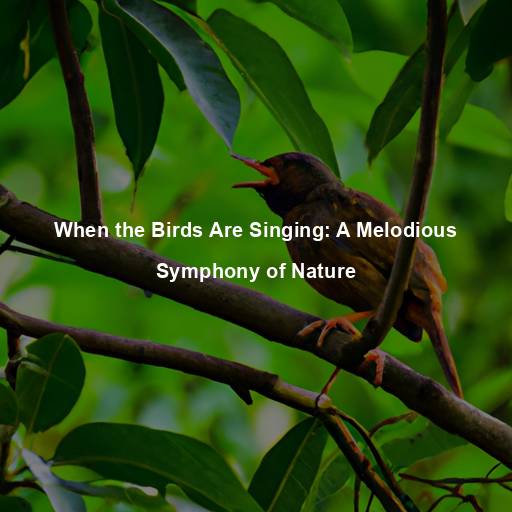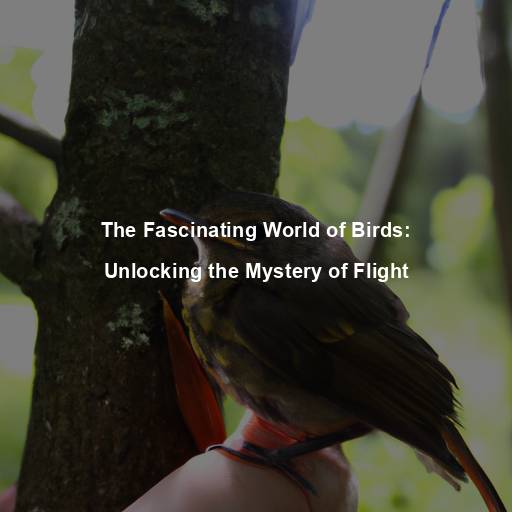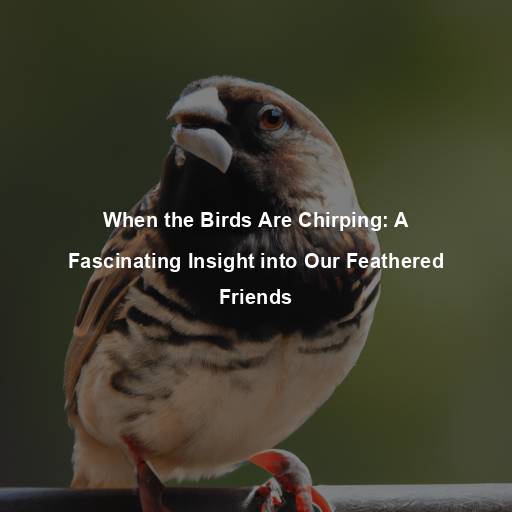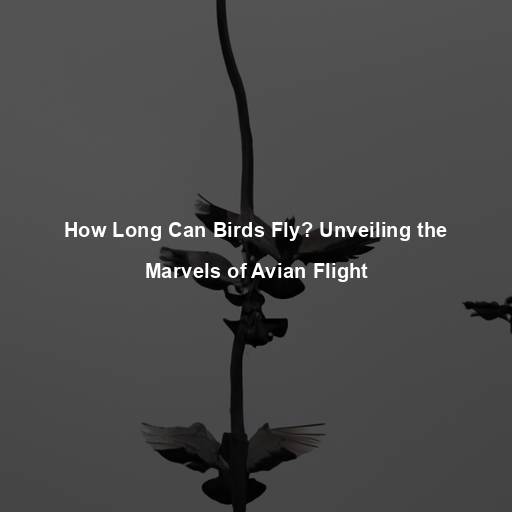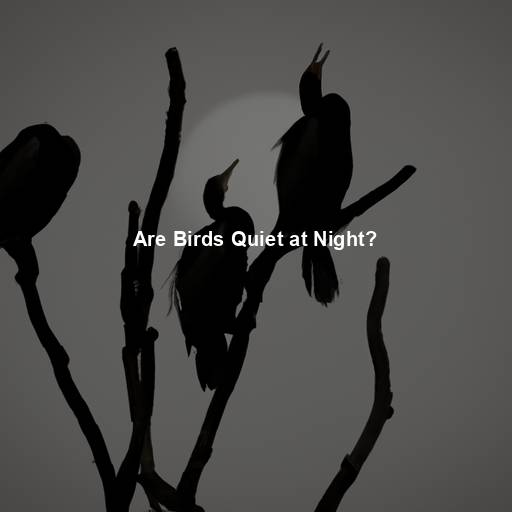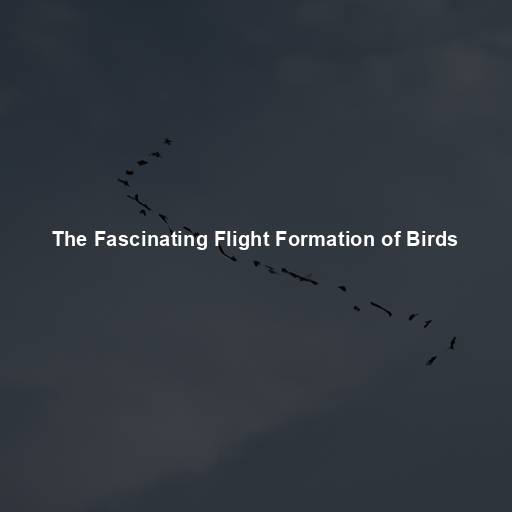When the Birds Are Singing: A Melodious Symphony of Nature
Last Updated on July 30, 2023 by Evan
Contents [hide]
- 1 The Enchanting World of Birds
- 1.1 The Language of Birds
- 1.2 The Dawn Chorus: A Musical Awakening
- 1.3 The Science of Birdsong
- 1.4 The Anatomy of Songbirds
- 1.5 The Cultural Significance of Birds
- 1.6 Birdsong and Human Well-being
- 1.7 Preserving Birdsong: A Call to Action
- 1.8 Ancient Origins of Birds
- 1.9 The Emergence of Vocal Communication
- 1.10 Adaptations for Singing
- 1.11 The Influence of Environment and Social Factors
- 2 The Musicality of Birdsong
- 3 The Science of Birdsong and Its Implications
- 4 The Universal Language of Nature
- 5 The Cultural Significance of Birds in Human History
- 6 The Joy of Birdwatching and Pet Birds
- 7 The Future of Birds: Conservation and Coexistence
- 8 FAQs: When the Birds are Singing
The Enchanting World of Birds
There is an undeniable allure to the avian world, an enigmatic realm that continues to bewitch and intrigue us. From their heavenly glide through the cerulean sky to their kaleidoscope of feathers that shimmer in the sun’s gentle touch, birds are the ultimate embodiment of ethereal beauty. Yet, hidden beneath their delicate facade lies a mystery waiting to be unraveled. What secrets lie within the harmonious melodies that cascade from their beaks, enchanting our senses and beckoning us into their realm of wonder?
The Language of Birds
Birdsong is not merely a random collection of notes; it is a complex and intricate form of communication. It serves various purposes like attracting mates, defending territories, and warning of danger. Each species has its distinct repertoire of calls and songs, allowing them to convey specific messages to their fellow birds.
The Dawn Chorus: A Musical Awakening
There’s something truly captivating about the way the avian world awakens each morning. As the sun peeks over the horizon, a symphony of bird songs fills the air, painting the dawn with a melody that defies explanation. It’s as if these resilient creatures have forged an unbreakable bond with the natural world, an alliance that leaves us in awe of their vitality and spirit. The dawn chorus is a bewitching phenomenon that reminds us of the magic that exists right outside our doorstep, waiting to be discovered.
The Science of Birdsong
Throughout history, the captivating melodies of birdsong have bewildered and intrigued the minds of countless scientists and researchers, igniting a hunger for knowledge that knows no limits. Diving headfirst into the enigmatic world of avian communication, these tireless explorers have unveiled a wondrous revelation – birdsong is not merely a birthright, but a skill honed over time, resembling the intricate acquisition of language in our own human existence. In a mesmerizing dance of intergenerational transmission, fledgling birds find themselves entranced by the melodic teachings of their esteemed mentors, oftentimes their very own feathered kin, in a phenomenon known as vocal learning. A symphony of perplexing discoveries, echoing with the harmonious cadence of intrigue and astonishment.
The Anatomy of Songbirds
To produce their melodious tunes, songbirds possess specialized vocal organs. The syrinx, located at the base of the trachea, is the primary sound-producing organ in birds. It allows them to create a wide range of sounds and mimic various environmental sounds, including those of other bird species.
The Cultural Significance of Birds
Beyond their scientific significance, birds hold a special place in human culture and folklore. In many ancient civilizations, birds were considered divine messengers, symbols of freedom, and even omens of good fortune or impending doom. Their presence in literature, art, and mythology throughout history reflects our deep connection and fascination with these winged creatures.
Birdsong and Human Well-being
Have you ever noticed how the enchanting serenades of birds can magically transport you to a realm of tranquility? Surprisingly, scientific studies have validated the remarkable influence of these melodies on our well-being. Not only do their soothing tunes offer solace for our stressed souls, but they also have the power to uplift our spirits and sharpen our focus. It’s no wonder, then, that therapeutic practices like sound healing and ecotherapy have harnessed the profound impact of bird song to nurture our mental and physical equilibrium.
Preserving Birdsong: A Call to Action
As our urban landscapes expand and natural habitats diminish, the preservation of bird populations and their songs becomes crucial. Human activities like deforestation, pollution, and climate change pose significant threats to bird species worldwide. By taking steps to protect and restore their habitats, we can ensure that the melodious symphony of birds continues to resonate in our lives for generations to come.
In a mesmerizing display of ethereal beauty, the intricate melodies of birdsong captivate our senses and remind us of the delicate interweaving of nature’s tapestry. These enchanting tunes not only please our ears but communicate a nuanced symphony of emotions, from expressions of love and warning to joyous celebration. As we marvel at the harmonious orchestra of avian voices, let us pause and reflect on the profound impact these feathered creatures have on our existence. By safeguarding their habitats and ensuring a future that is in harmony with nature, we can embark on a wondrous journey where the melodic cadence of birdsong uplifts our spirits and permeates our very souls.
Ancient Origins of Birds
Birds are descendants of dinosaurs, and their evolution spans millions of years. Fossil evidence suggests that the earliest birds appeared during the Jurassic period, approximately 150 million years ago. These primitive birds, such as Archaeopteryx, possessed feathers and bird-like skeletal features but lacked the ability for complex vocalizations.
The Emergence of Vocal Communication
Throughout the course of avian evolution, an extraordinary phenomenon occurred. As if unraveling the enigmatic secrets of existence, birds underwent a mesmerizing transformation in their ability to create resounding symphonies. The emergence of anatomical marvels called syrinx, bespoke vocal structures, unfurled a magnificent repertoire of intricate and melodious songs. This phenomenon opened a captivating gateway into the realm of vocal communication, serving as a vital survival mechanism, empowering these feathery creatures to demarcate territories, entice potential mates, and thwart the relentless advances of predators.
Adaptations for Singing
Birdsong is not solely dependent on the syrinx; it also involves the coordination of various muscles and air sacs. Different bird species have unique adaptations that enable them to create a diverse range of sounds. For example, some birds have highly developed vocal muscles, while others possess specialized resonating chambers that enhance the quality and volume of their songs.
The Influence of Environment and Social Factors
Birds are highly adaptable creatures, and their songs can vary depending on their environment and social interactions. Factors such as habitat, climate, and even the presence of other bird species can influence the structure and complexity of their songs. Some birds, like the mockingbird, are renowned for their ability to mimic the sounds of other birds and even non-avian sounds.
The Musicality of Birdsong
Melody and Rhythm
When it comes to the enchanting world of birds, their song is a perplexing marvel that leaves us utterly captivated. Resonating through lush meadows and towering forests, these melodic symphonies bear an uncanny resemblance to our own human melodies. With a rhythmic flourish, feathered virtuosos showcase their prowess, weaving intricate patterns and captivating us with their musical narrative. Whether it be the sophisticated harmonies of some species or the hypnotic rhythms of others, these avian maestros utilize repetition and motifs, crafting a spellbinding musical tapestry that both astounds and bewitches.
Complexity and Variation
Birdsong is not a monotonous repetition of the same notes; it is characterized by complexity and variation. Birds incorporate a wide range of sounds, from high-pitched trills to low-pitched warbles, into their songs. They can also modify their songs in response to environmental cues or during courtship displays, showcasing their versatility and adaptability.
Individuality and Cultural Transmission
Birds, like us, express themselves through their very own melodic compositions. Each bird’s song acts as a personal signature, granting them a sense of belonging within their feathery communities. Fascinatingly, some bird species acquire their musical prowess by mimicking seasoned mentors, leading to captivating dialects and diverse cultural expressions within their ranks. This intricate transmission of melodies adds a touch of mystique to the enchanting world of avian music.
The Science of Birdsong and Its Implications
Studying Birdsong
Delving into the enigmatic world of birdsong, scientists employ a plethora of techniques to untangle its perplexities. Fascinatingly, the utilization of spectrograms enables these inquisitive minds to visualize and dissect the intricate components, encompassing pitch, duration, and frequency, woven into the melodious tapestry of bird songs. Through the meticulous examination of neural pathways and brain regions implicated in birdsong production, an ethereal window is opened, shedding light on the enigmatic neurological underpinnings of vocal learning and communication among our avian counterparts.
Birdsong as a Model for Human Speech
The study of birdsong has provided valuable insights into the mechanisms underlying human speech and language. Both humans and birds share similar neural and behavioral processes involved in vocal learning. By understanding how birds acquire and modify their songs, researchers gain a deeper understanding of the fundamental principles of vocal communication, which can have implications for speech therapy and language disorders in humans.
Conservation and Ecological Significance
There is an undeniable allure to the enchanting symphony of birdsong that graces our lives. Beyond its aesthetic appeal, though, lies a deeper significance that often eludes us. The melodious tunes that emanate from the feathered inhabitants of our surroundings serve as delicate messengers, whispering secrets about the state of our environment. As guardian angels of ecological balance, birds offer us invaluable insights into the health of our habitats and the impending perils of climate change.
Human-Bird Interactions
Humans have long been captivated by birdsong, leading to interactions that have shaped both bird behavior and human culture. Bird enthusiasts and scientists have developed technologies such as field guides, audio recordings, and smartphone apps to identify and appreciate the diverse array of bird songs. These interactions foster a deeper appreciation for birds and their conservation, creating a harmonious relationship between humans and the avian world.
The Universal Language of Nature
A Source of Inspiration
For centuries, the ethereal melodies of birdsong have captivated the hearts and minds of creative souls from all walks of life. The enchanting harmonies and mesmerizing rhythms that emanate from nature’s own symphony have acted as an irresistible muse, sparking an immeasurable number of artistic ventures. Whether it be the haunting notes of the nightingale or the percussive beats of the woodpecker, the enigmatic songs of our feathered friends beckon us to delve into the mesmerizing tapestry of the natural realm, unraveling its intricate beauty and captivated perplexity at every melodic turn.
Connecting with Nature
There is something truly captivating about the sweet melodies that fill the air, transporting us to a serene realm far removed from the bustling chaos of city life. It is in these moments, whether we find ourselves wandering through a serene park or merely pausing to listen from the comfort of our own homes, that we are reminded of the profound link we share with the natural world. A symphony orchestrated by our feathered friends serves as a gentle yet powerful reminder of the urgency to protect and nourish the delicate tapestry of life that surrounds us.
A Call to Action
As the mesmerizing melodies of birds fill the air, a certain unease lurks beneath the surface – the looming threats that these winged wonders confront in a world increasingly shaped by humanity. The destruction of their habitats, the relentless grip of climate change, and the ominous presence of pollution pose formidable challenges to our feathered friends. Yet amidst the perplexing puzzle of these alarming realities, lies a glimmer of hope – a call to action. By wholeheartedly embracing conservation endeavors, diligently crafting bird-friendly sanctuaries, and unflinchingly raising consciousness about the invaluable role birds play, we can collectively safeguard these extraordinary creatures and ensure the perpetuation of their enchanting harmonies.
In the vast orchestration of existence, the enchanting symphony of bird melodies emerges as a captivating reminder of the interconnectedness of all living beings. Each warble, trill, and chirp resonates with a mysterious beauty that permeates the very essence of our world. When we find ourselves captivated by these dulcet tones, we are invited to pause, to absorb, and to contemplate the profound importance and intricate significance of avian songs. Let us allow the language of birds to uplift our souls, inspiring a profound connection with the natural tapestry that envelopes us all, leaving us marveling at the enigmatic wonders of our ecosystems.
Seed Dispersal
Birds, with their insatiable fruit cravings, unknowingly serve as Mother Nature’s seed-spreaders. As they feast on the ripest fruits and juiciest berries, little do they know that they carry within their bellies the future of various plant species. Through their delightful droppings, these avian wanderers unknowingly sow the seeds of life, scattering them far and wide. This wondrous act of seed dispersal is Nature’s secret to fostering vibrant plant communities, enabling them to colonize new and unexpected corners of our magnificent planet.
Pollination
Certain bird species, such as hummingbirds and sunbirds, act as important pollinators for flowering plants. As they feed on nectar, pollen sticks to their feathers or beaks and is inadvertently transferred from flower to flower. This mutualistic relationship between birds and plants ensures the continued reproduction and survival of many plant species.
Insect Control
Birds play a fascinating role in nature’s delicate balance, acting as tireless insect hunters who safeguard our crops and health. With their insatiable appetites, species like swallows and flycatchers display a remarkable knack for devouring hordes of pesky bugs daily. This awe-inspiring feat not only grants us a free and environmentally friendly pest control service but also diminishes our reliance on potentially harmful chemical pesticides.
Nutrient Cycling
Birds also contribute to nutrient cycling within ecosystems. As they consume insects, fruits, and seeds, they excrete waste that contains valuable nutrients. This waste acts as natural fertilizer, enriching the soil and promoting plant growth. In this way, birds play a vital role in maintaining the health and productivity of ecosystems.
The Cultural Significance of Birds in Human History
Symbols of Freedom and Spirituality
Birds have long been associated with freedom, flight, and the human spirit. In many cultures, birds symbolize transcendence, representing the ability to rise above earthly limitations and connect with the divine. Their ability to soar through the skies has inspired countless myths, legends, and spiritual beliefs throughout human history.
Artistic Inspiration
Birds have served as muses for artists, poets, and writers across different artistic mediums. Their vibrant plumage, graceful flight, and melodic songs have inspired countless works of art, literature, and music. From ancient cave paintings to Renaissance masterpieces, birds have left an indelible mark on the creative expressions of humanity.
Ornithology and Scientific Exploration
For centuries, the mesmerizing world of ornithology has captured the boundless imagination of scientific minds, igniting an insatiable curiosity that transcends time. From the early pioneers whose eyes traced the graceful flight of birds, like the revered naturalist John James Audubon, to the relentless pursuit of knowledge by today’s cutting-edge researchers armed with technological marvels, our understanding of winged wonders has undergone an exhilarating metamorphosis. Dive into this captivating realm and uncover the hidden treasures of avian adaptations, behaviors, and the intricate tapestry of their ecological roles that continue to perplex and astonish even the most seasoned explorers of this ethereal domain.
Birds in Mythology and Folklore
Birds have held prominent roles in mythology and folklore across cultures around the world. They have been seen as messengers, omens, and even deities. The ancient Egyptians revered the ibis as a symbol of wisdom, while the phoenix, a mythical bird, represented rebirth and immortality in various mythologies.
The Joy of Birdwatching and Pet Birds
Birdwatching as a Hobby
Birdwatching, or birding, has become a popular recreational activity worldwide. Enthusiasts armed with binoculars and field guides venture into natural habitats or set up feeders in their backyards to observe and identify different bird species. Birdwatching provides an opportunity to connect with nature, appreciate biodiversity, and contribute to citizen science initiatives.
Pet Birds as Companions
Our homes have become a haven for our avian companions, from the vibrant parrots to the charming canaries and finches. These feathered wonders bring not only joy and companionship but also a wealth of educational opportunities to their fortunate owners. However, ensuring their well-being requires a mindful commitment to providing them with the care, enrichment, and environments that pay homage to their wild origins.
Responsible Bird Ownership
When it comes to welcoming a feathered companion into your home, the stakes are high. All too often, the complexities of caring for a pet bird are brushed aside. But, dear reader, let me assure you that the responsibility is no flight of fancy. A spacious and stimulating habitat, a well-balanced diet, and consistent veterinary attention are mere feathers in the cap of bird ownership.
The Future of Birds: Conservation and Coexistence
Threats to Bird Populations
Birds face numerous threats in the modern world, primarily due to human activities. Habitat loss, climate change, pollution, and invasive species pose significant challenges to bird populations globally. Understanding these threats and taking proactive measures to address them is crucial for the conservation of avian biodiversity.
Conservation Strategies
Conservation efforts are underway to protect and restore bird habitats, establish protected areas, and promote sustainable practices. Organizations and individuals work together to raise awareness, conduct research, and advocate for policies that safeguard birds and their habitats. Supporting these initiatives, such as participating in citizen science projects or creating bird-friendly gardens, can make a significant difference.
Promoting Coexistence
As human populations expand, finding ways to coexist with birds is essential. Implementing bird-friendly practices, such as minimizing the use of pesticides, avoiding the destruction of nesting sites, and keeping cats indoors, can help reduce human impacts on bird populations. By fostering a harmonious relationship between humans and birds, we can ensure their survival and the continued enjoyment of their melodious songs.
FAQs: When the Birds are Singing
Why do birds sing?
Birds sing for various reasons, and the primary purpose of their singing is usually to communicate. Male birds often sing to establish and defend their territory, signaling to other males that the area is already claimed. Singing is also a way for male birds to attract females during the breeding season. Additionally, birds use their songs to communicate their location to their flock or to warn of potential threats. Singing is an essential part of their social behavior and helps maintain their species’ survival.
When do birds typically start singing?
As the world awakens and the sun begins to peek over the horizon, an enchanting symphony fills the air – the dawn chorus. Nature’s melodious ambassadors of the sky, birds, burst into song, their voices intertwined in a perplexing harmony. This magical phenomenon unfolds in the early morning hours, a vibrant display of avian communication and territorial grandeur. It is during this breeding season that the chorus reaches its crescendo, as feathered performers pour their hearts into attracting mates and fiercely protecting their domain.
Do birds sing at night?
In the enchanting realm of avian melodies, where the sun embraces the sky, we witness a rare and beguiling phenomenon. While the majority of our feathered friends choose to serenade us during the vibrant hours of daylight, a select few dare to venture into the mysterious realm of nocturnal symphonies. As the breeding season unfolds, these courageous males take to the twilight stage, their melodic endeavors serving as an ode to both territorial dominance and courtship. Yet, let us not be fooled by their enchanting tunes, for this nocturnal escapade remains a tantalizing enigma, confined to the world of a select few, such as the illustrious nightingale and the charismatic mockingbird.
What influences the intensity and frequency of bird songs?
Several factors can influence the intensity and frequency of bird songs. One significant factor is the breeding season. Male birds tend to sing more frequently and loudly during this period as they compete for mates and establish territories. Environmental conditions, such as the availability of food or the presence of predators, can also influence the intensity of bird songs. Additionally, individual bird species may have specific behavioral patterns that dictate when and how frequently they sing.
Can different bird species be identified by their songs?
Yes, bird species can often be identified by their unique songs. Each bird species has a specific song pattern or repertoire that distinguishes it from others. By familiarizing themselves with the various bird songs in their area, birdwatchers and ornithologists can effectively identify different species based on their distinct vocalizations. Bird songs can vary greatly in terms of pitch, rhythm, melody, and complexity, allowing for accurate species identification through careful observation and knowledge of bird vocalizations.
Are bird songs the same across the world?
Bird songs are not the same across the entire world. Each geographical region has a unique avian population with its own distinct set of bird species. The songs of birds can vary depending on their habitat, environment, and evolutionary adaptations to their specific region. For example, tropical bird species may have more intricate and melodic songs, while birds in desert regions might have simpler vocalizations. It is fascinating to explore the diversity of bird songs across different parts of the world and appreciate the beauty of their unique vocal expressions.

